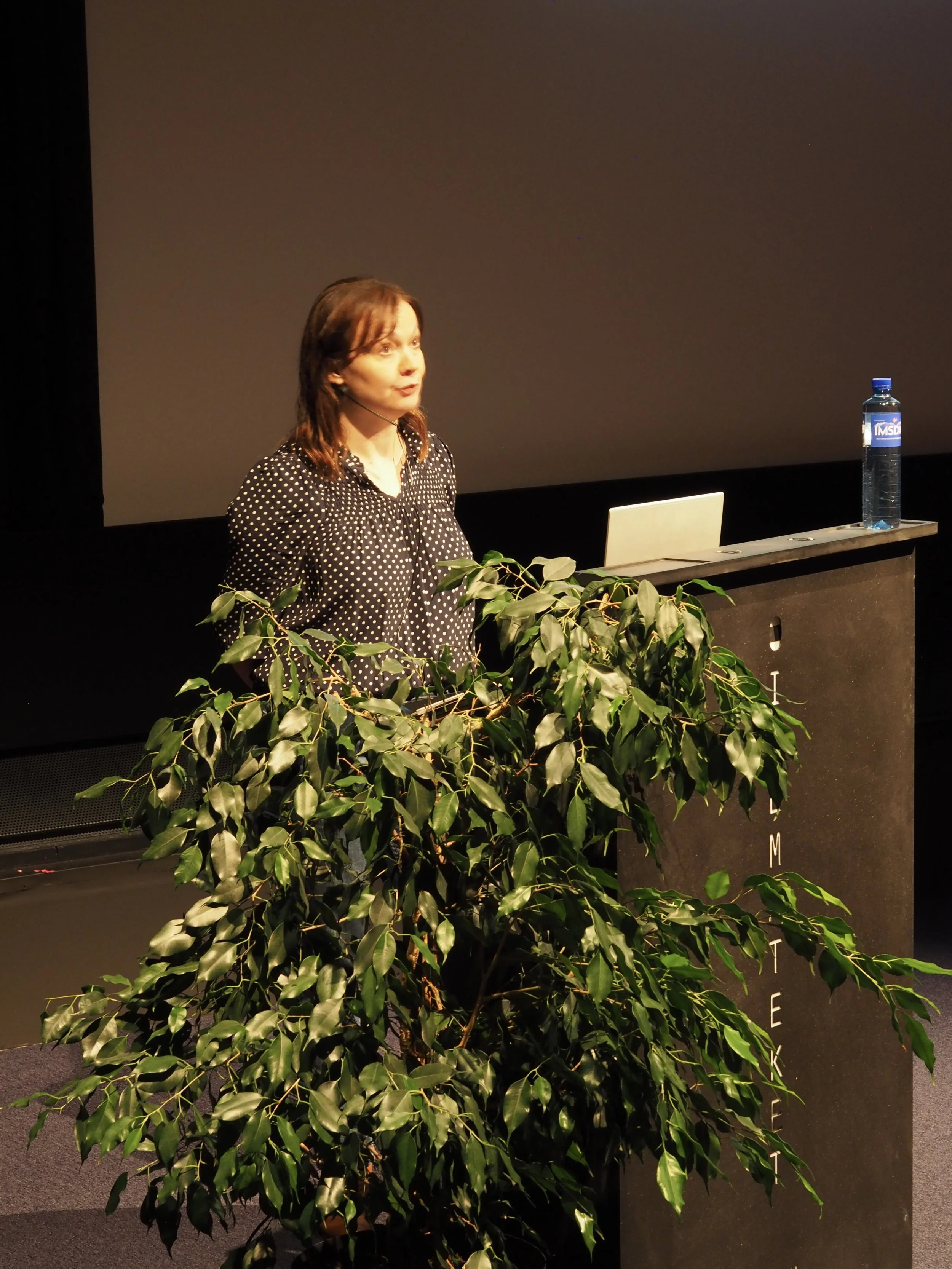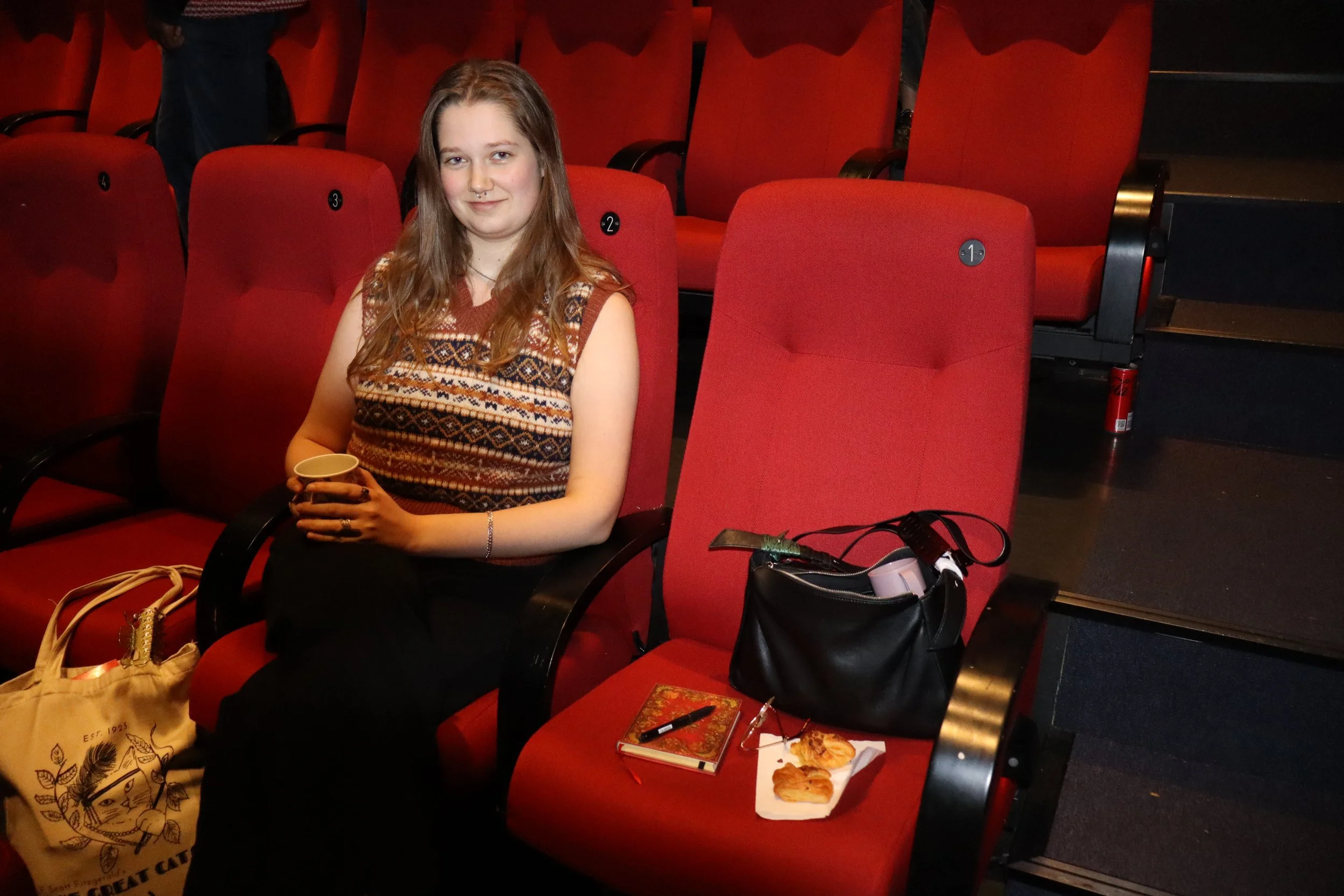A Weekend of Cult — NFK’s annual film seminar
Feature - Siri Lill Berg and Emma Francke Husebø
In October, we joined a cult… film seminar. We visited Cinemateket for Filmklubbforbundet and Z filmtidsskrift’s annual film seminar. This year’s theme was cult cinema. We spent our weekend listening to four informative lectures coupled with four interesting films, and then interviewed four academics on their respective interest regarding the cult genre.
Siri and Kate Egan during an interview, discussing queerness and horror films. Photo: Emma Francke Husebø
Norwegian cult film seminar
The Norwegian Film Club Association (Norsk Filmklubbforbund, NFK) organises three seminars each year. In Oslo the seminars are in the fall, where NFK and Z film magazine organise a weekend seminar with films and lectures to a selected theme. This years theme was cult film, and our weekend consisted of two days, with two lectures and two films each.
The speakers focused on four different themes, shedding light on four different aspects of cult films. This made the audience get a good idea of the diversity existing within the cult film concept. After the lectures the speakers opened for some questions. We were lucky to be able to interview this year’s speakers on their topics, as well as ask other questions connected to cult cinema and get some exclusive recommendations.
FAQs and Fun Facts
How does a film become a cult film?
Steve Rawle explained that films aren’t made cult by the production, but by the fans.
Are there common characteristics in cult films?
Yes! Steve Rawle tells us. Among them are: Innovation, badness, transgression, intertextuality, nostalgia, genre (within or in defiance of-), narrative openness, (loose ends, either due to complexity or ineptitude), and simple “gore”.
Who are Cult Film fans?
Iain Robert Smith elaborates on the whiteness on cult, and how the stereotypical cult film fan is most often presented as a young, nerdy, white male. He emphasises though that this image is problematic, and discusses how to view cult film through a decolonial lense.
According to their Instagram, The Happiness of the Katakuris was the most expensive movie Norsk Filmklubb Forbund has ever shown. This might be because it was shown on 35mm film, shipped from Japan.
The second film on the program Who Killed Captain Alex? features a VJ making humorous commentaries throughout the film. The original edit was deleted off the directors computer to make more room, so the only version of the film that exists is with humorous commentary from VJ (Video Joker) Emmie.
George Harrison is credited as an executive producer on Withnail and I, due to him co-founding the films production company. The same company made Monty Python’s Life of Brian.
The director Shin Sang-ok was kidnapped by North Korea to make films for the country. In the end he made a number of films and he was rumored to have liked it, as his career in South Korea was slowing down and he just wanted to make films.
Steve Rawle: The Happiness of the Katakuris as a model cult film
The Happiness of the Katakuris (2001) / Foto: IMDb
Opening the filmseminar was Steve Rawle, who gave a good introduction to the cultfilm-genre in general. Cult films are, as Rawle put it, made by the audience and their practices, meaning, film makers cannot set out to make a cult film. Some qualifiers of a cult-films was also mentioned, one of them being playing typical genre conventions, meaning you never really know what you are getting. This fits perfectly with The Happiness of the Katakuris which Rawle defined as “The Ultimate Super-Happy-Zombie-Romance-Murder-Mystery-Family-Comedy-Karaoke-Disaster-Movie-Part-Animated-Remake-All-Singing-All-Dancing-Musical-Spectacular-Extravaganza: The Happiness of the Katakuris as a model cult film”. As Rawle description would suggest, this film is a fever fantasy.
Rawle during his lecture. Photo: Marte Stapnes
During our interview, we asked him to elaborate on what happens when cult films becomes mainstream, which he mentioned in his lecture. Among other things mentioning how practices can become mainstream, but still remain cult when done in the right context, like at the cinema. He does however mention that “once it becomes a singalong on disney plus, it’s probably stepped beyond [cult practices]”. When asked the question about a monster film recommendation he told us the story of the director, Shin Sang-ok, being kidnapped by North Korea to make movies.
Rec: Pulgasari (1985)
Iain Robert Smith: Global Cult Cinema Through a Decolonial Lens
“The cult viewer demographic was and is primarily white, male, middle- class, moderately to well-educated, and roughly between the ages of fifteen and thirty”
Iain Robert Smith during his lecture. Photo: Emma Francke Husebø
To close out day 1 of the seminar, Iain Robert Smith discusses the dominating “whiteness of cult” and measures to take to combat it. He establishes that the typical cult film fan is often imagined as a nerdy white male, but that this view is not only insufficient, it is reductive to cult fans, and problematic as it only reinforces the western dominance.
Some steps to decolonise cult include: Expanding the canon by incorporating films whose fandoms are predominantly amongst people of colour. As well as: Engaging specifically with non-western cult films and fandoms, in order to decolonise and broaden the category.
To do just that, Smith highlights cult films originating from African countries, for instance Nollywood (a nickname for the Nigerian film industry), and in particular “Who Killed Captain Alex?” (2010) from Uganda. Director Isaac Godfrey Geoffrey Nabwana produced, shot, wrote, and edited the film from a slum in Kampala, Uganda. Nabwana also founded a production company nicknamed Wakaliwood, whose productions are know for low budget action movies.
In our interview we spoke about Smith’s interest in specifically Indian cult films. Which has influenced a desire in him to learn Hindi, and led us to his recommendations for Indian cult films.
Reading recs: Jeffrey Sconce, particularly “Trashing” the academy: Taste, excess, and an emerging politics of cinematic style (1995).
Viewing recs: Works from the Ramsay Brothers (Indian producers). Smith highlights Veerana (1988) and Mahakaal (1994).
Becky Bartlett: «The Best of the Worst: Plan 9 and the Cult of the Bad Movie»
One of the UFOs from Plan 9 (1958)/Photo: IMDb
Starting of day 2 of the cultfilmseminar, was Becky Bartlett and her presentation on badfilms. She described badfilms as films that are so excessively bad they become good, which personally, would be all of my favourite movies. Accompanying her presentation was the film Plan 9 from Outer Space, often called the worst movie in the world. Plan 9 offered the audience an abundance of charmingly bad special effects, as well as attempts at covering up the fact that only a few of the scenes with Bela Lugosi’s character actually was him. In other words, the movie was bad, but entertaining—a badfilm.
Bartlett lecturing on badfilms. Photo: Siri Lill Berg
In our interview Bartlett explained that so many badfilms are horror movies mostly because they “already feels kind of bad”. Elaborating, she told us that horror films are getting away with a lot of the “bad stuff”, since their ambitions differs from non-horror movies, creating different standards and making the bad stuff matter less than in non-horror films. There are of course also the more obvious reasons, as camp-elements and financial situations, as well as horror movies actively trying to be appealing to a white male audience, which can make them appealing even as bad films.
Rec: God Told Me To (1976)
Kate Egan: Holy Grails and Withnails: Certain Tendencies of British Cult Cinema
Dr. Kate Egan on British Cult Cinema. Photo: Emma Francke Husebø
Kate Egan discusses the influence of a youth-oriented counterculture in Britain in the late 1960s. The transgressive nature of cult cinema allowed the British cult film to promote counterculture, and to deconstruct and challenge cultural conventions. In the film Withnail and I (1987, dir. Bruce Robinson) this is particularly apparent through how it highlights, and then subverts and challenges the idea of British masculinity through two young men in the late 60s.
Egan also introduces the time between the late 60 through late 70s as “the age of the cult film”. Because of the cultural movements at the time transgression and transcendence felt possible in a new way. British cult films like Withnail and I are often nostalgic to this time, another core characteristic of cult cinema.
Egan doing her lecture on British cult cinema. Photo: Marte Stapnes.
In addition to cult cinema, as it was close to halloween, we spent a lot of time speaking on horror films, which just happened to be one of Egan’s main areas of interest. Several speakers drew parallels between horror, cult films, camp aesthetics, and queerness. As mentioned above, certain cultural movements in Britain allowed gay male relationships to be explored, to a degree, and the ideas of masculinity were challenged and reconstructed. However, lesbian relationships did not get the same opportunities, and were more often simply ignored. Regarding this we spoke about queer horror, in which Egan could recommend: The Killing of Sister George (1968) and The Vampire Lovers (1970).
Reading recs: David Scott Diffrient (2023) Body Genre - Anatomy of the Horror Film, and Peter Marra (2025) Queer Slashers.
Viewing recs: The Wicker Man (1973), Witchfinder General (1968), The Blood on Satan's Claw (1971), The Killing of Sister George (1968), The Vampire Lovers (1970), We're All Going to the World's Fair (2021)
Final thoughts
We were lucky enough to be invited by NFK, and be welcomed by their general manager Marte Stapnes. During the weekend we have learned, we have laughed, and gotten great recommendations for our future movie nights.
Personal highlights from the seminar include: good food, good company, a box-shaped microphone (seen in the image below) being tossed around the the theatre during the question segments, and the karaoke scene of The Happiness of the Katakuris. Siri’s favourite lecture and film were Becky Bartlett on badfilm and Plan 9. Emma’s favourite lecture was from Iain Smith, on decolonising cult, and her favourite film was Withnail and I.
After the weekend we are left with a better insight into what a cult film can be.
We look forward to seeing what next years theme will be, and hope to be invited back!











